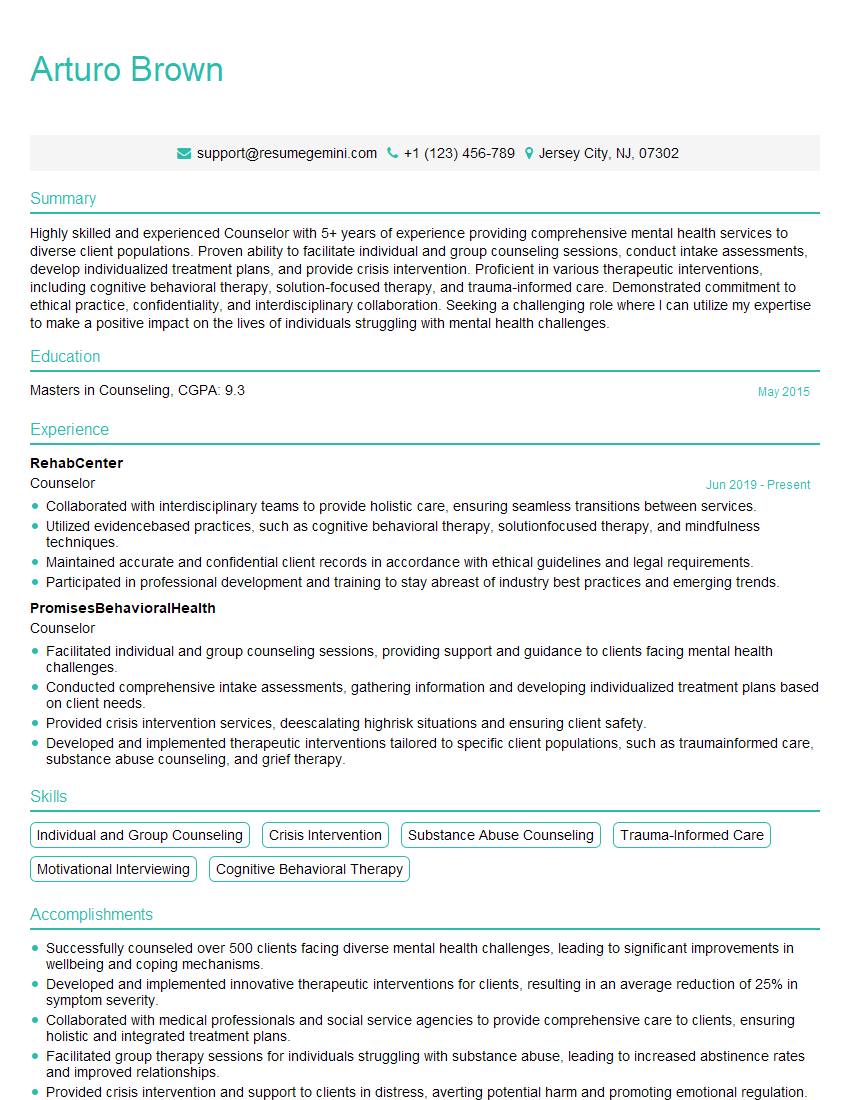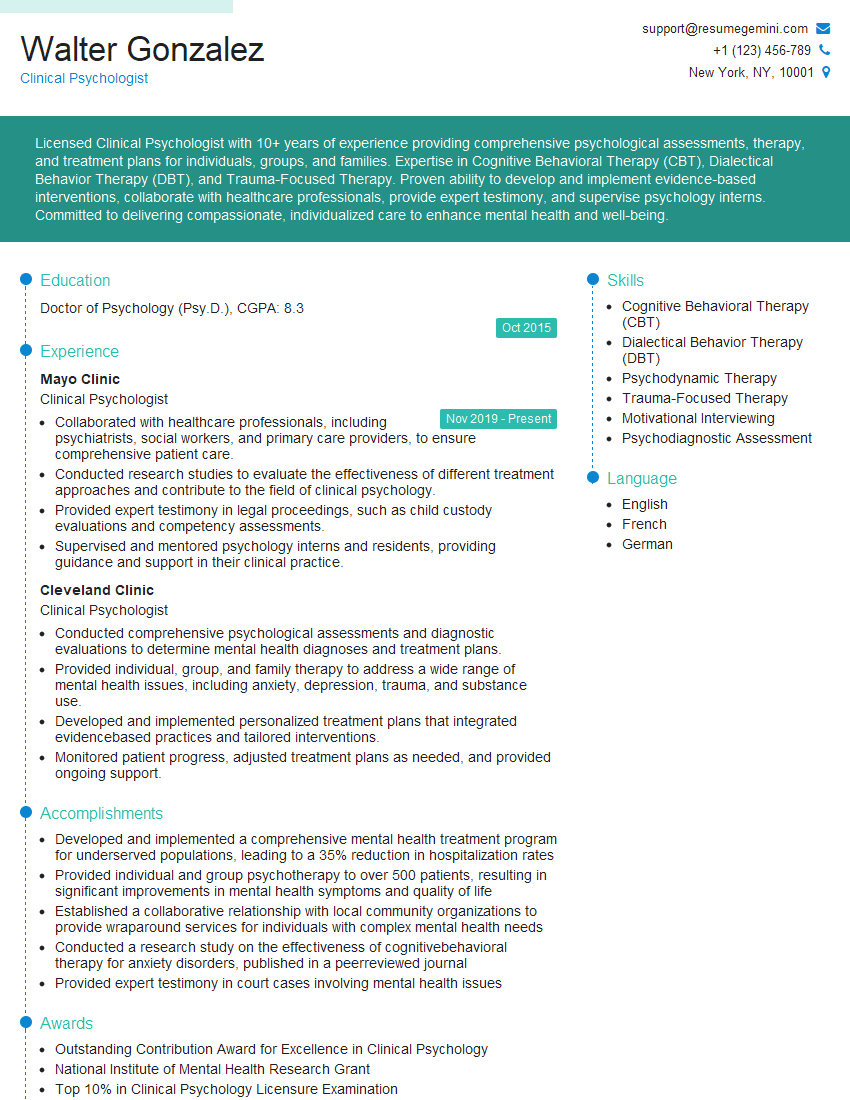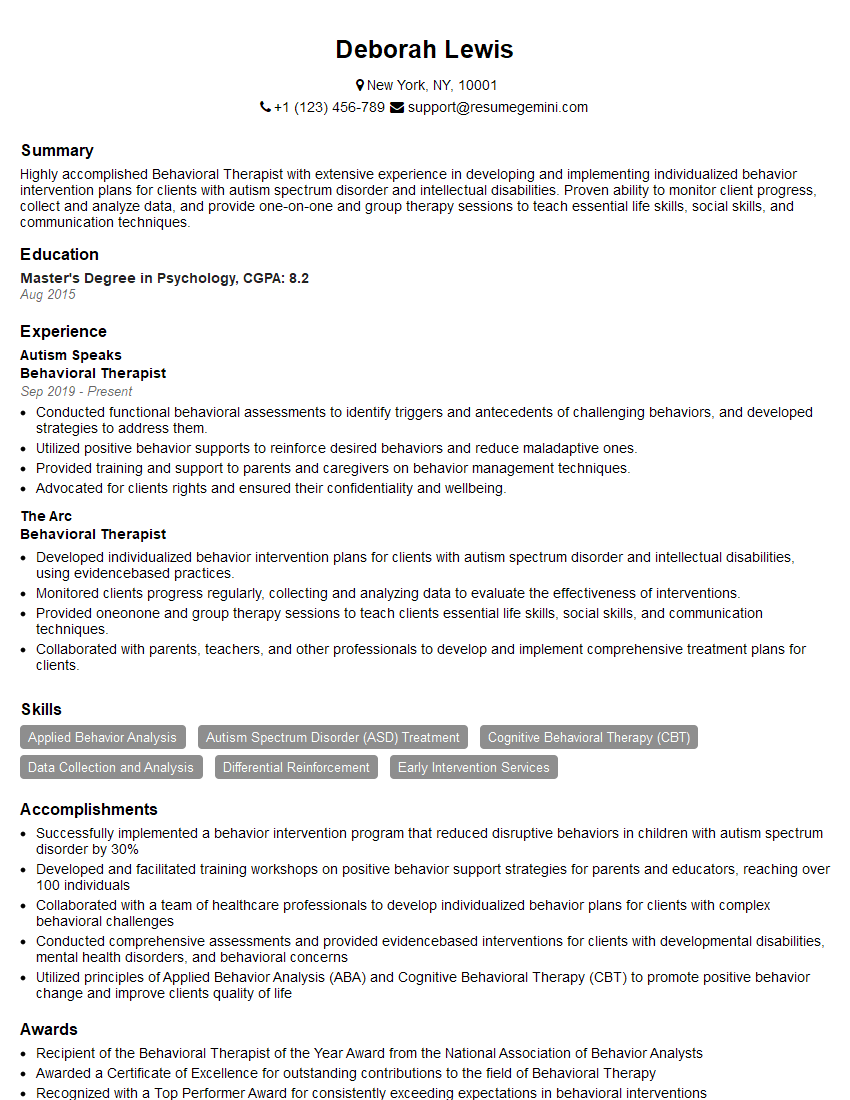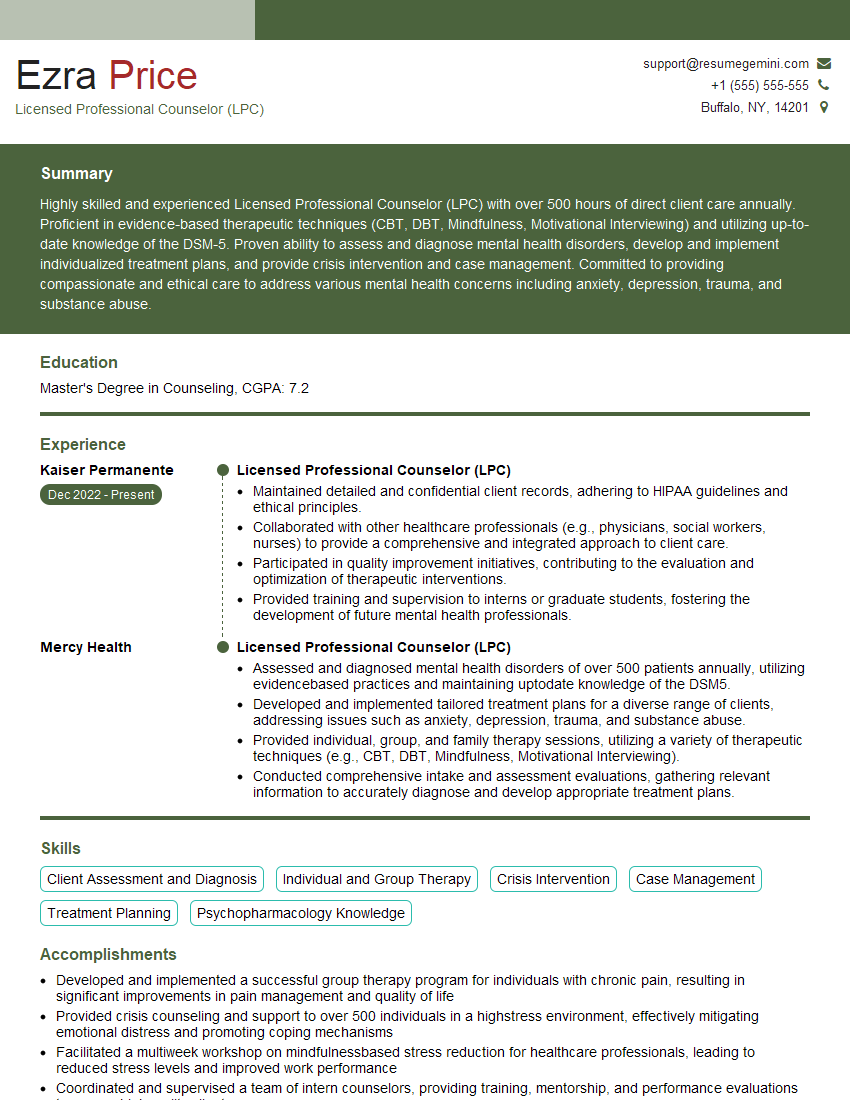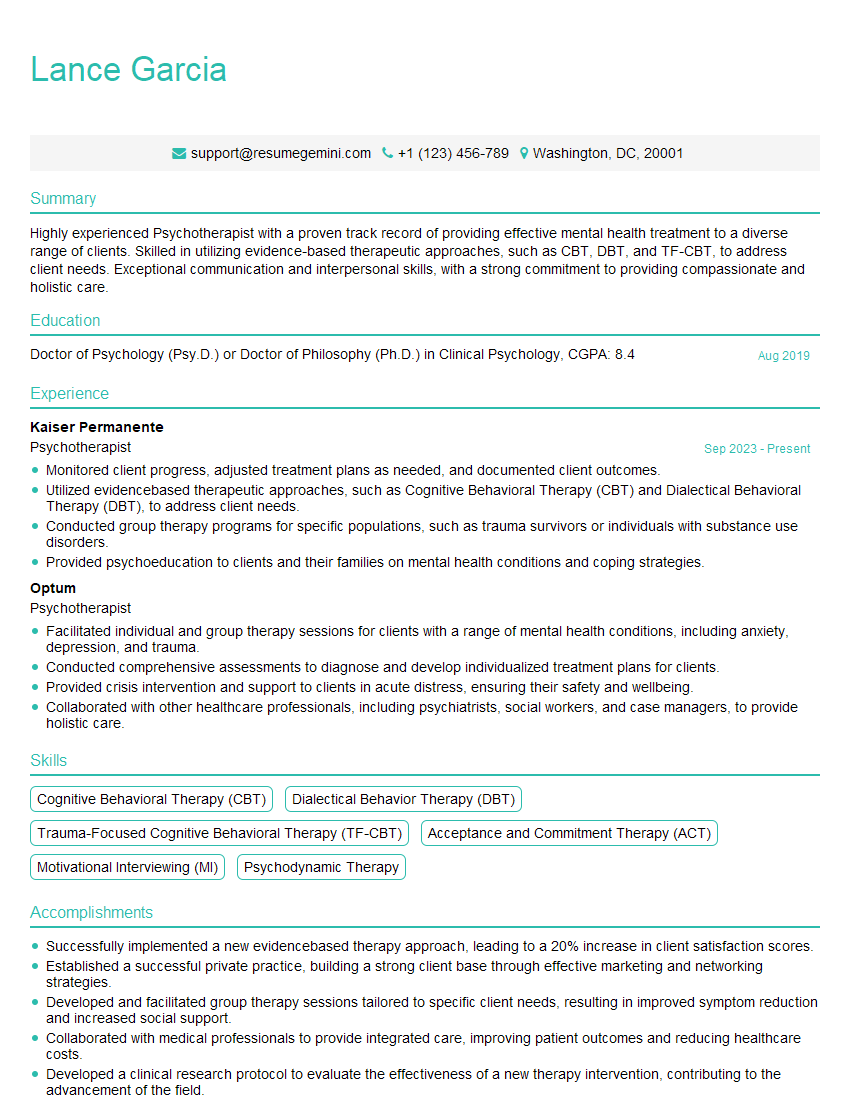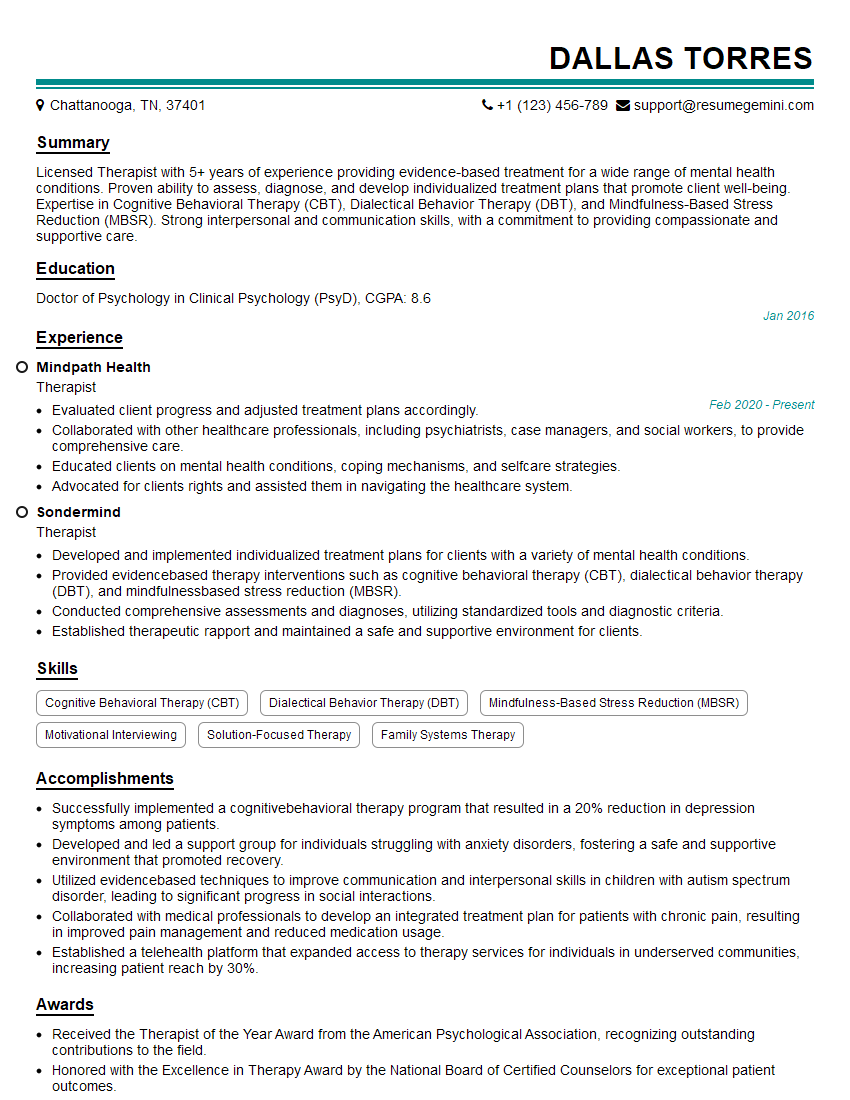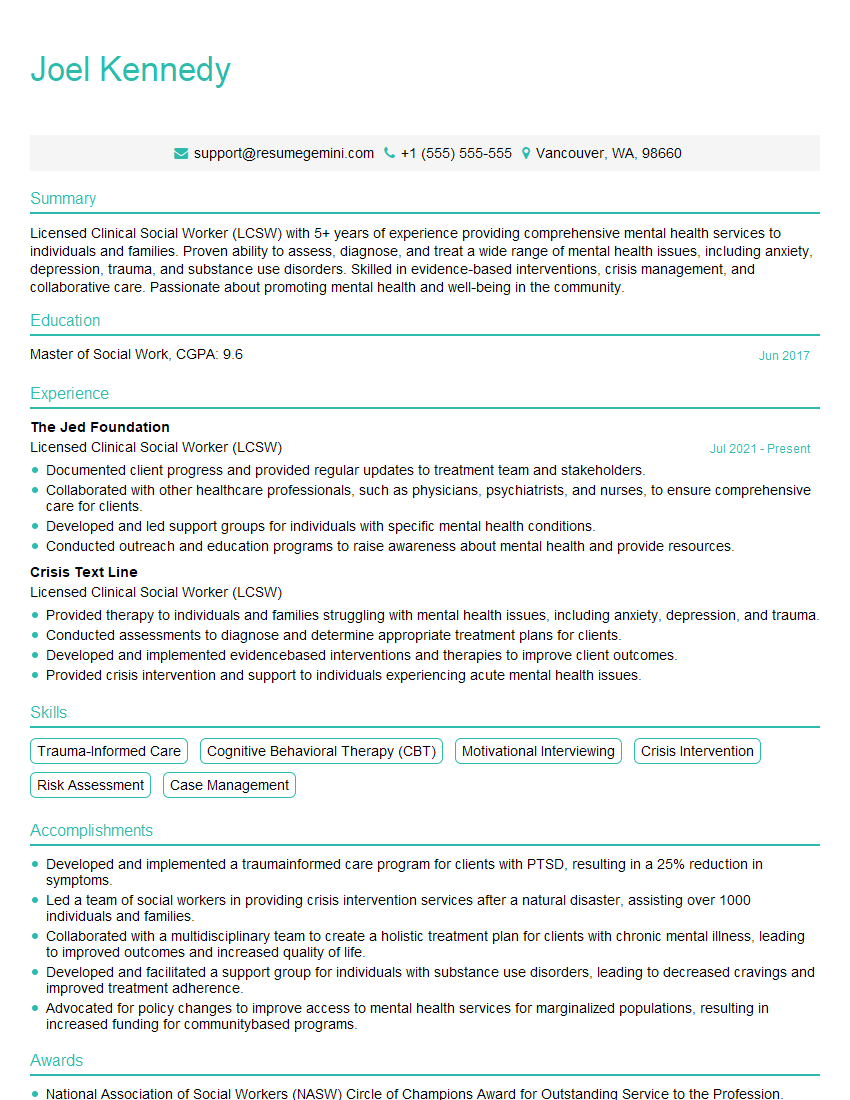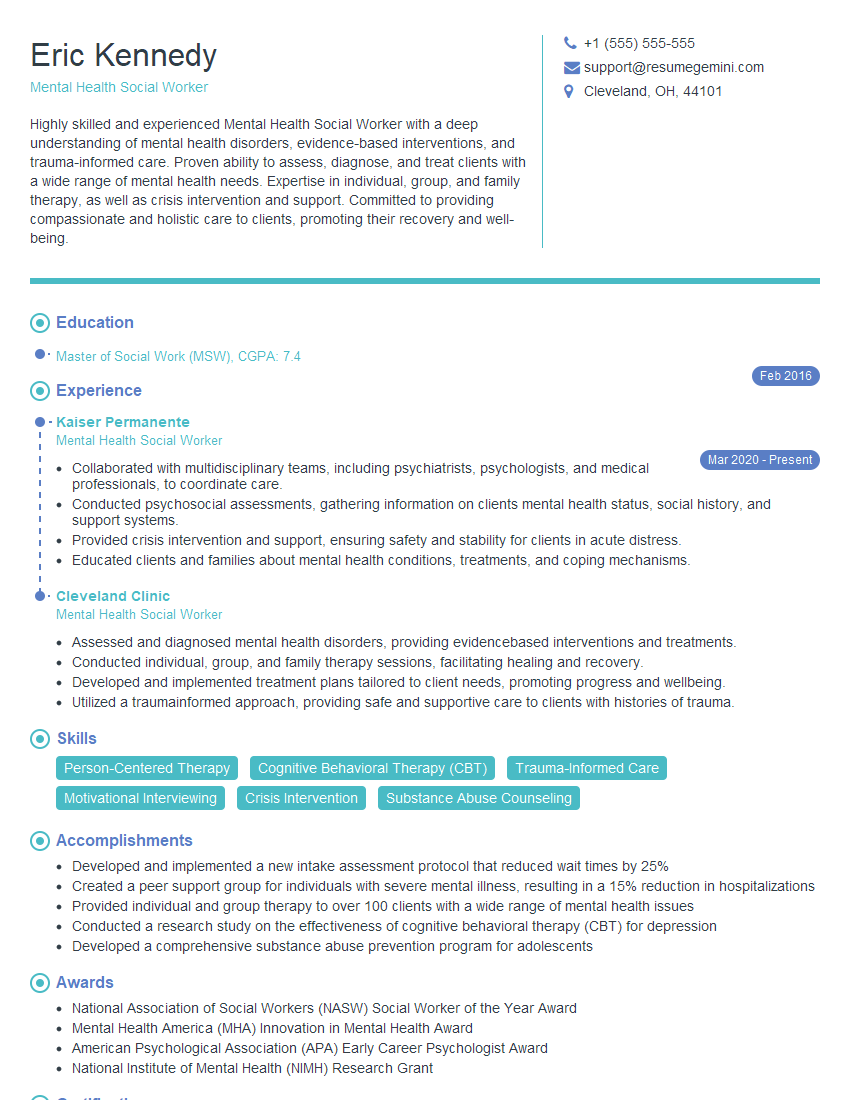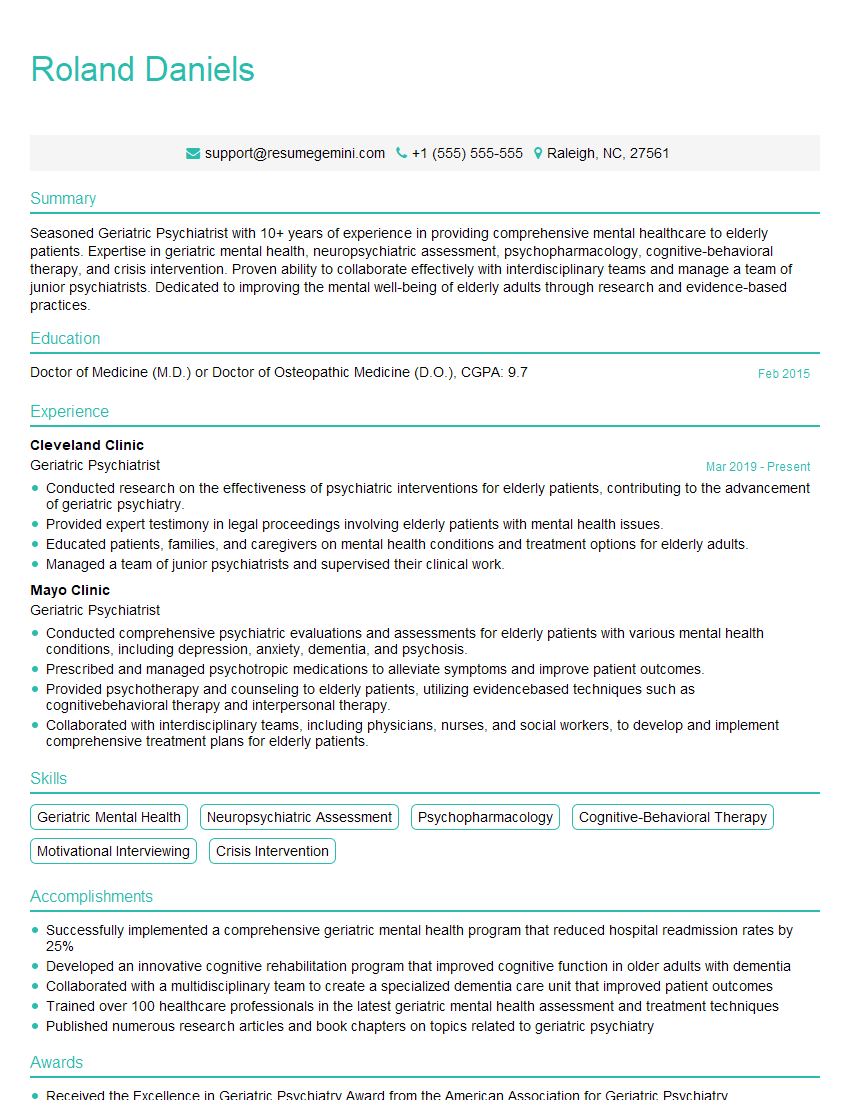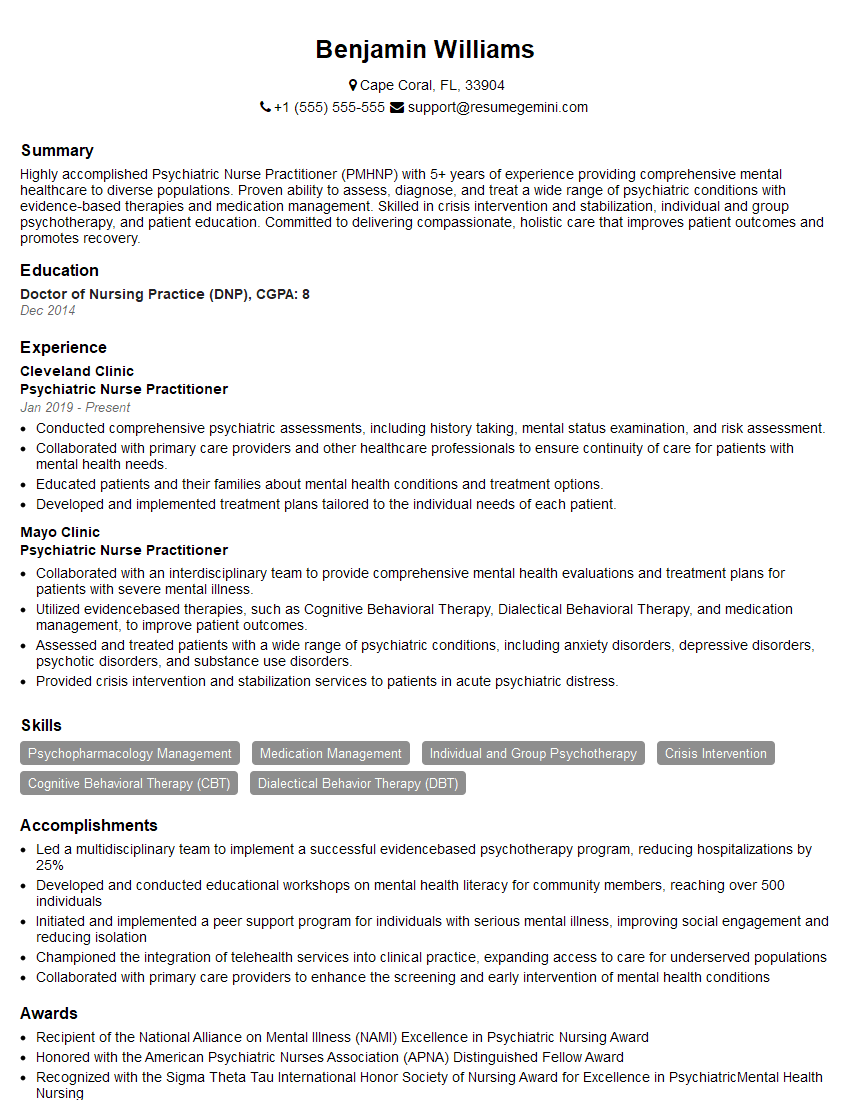The thought of an interview can be nerve-wracking, but the right preparation can make all the difference. Explore this comprehensive guide to Social Anxiety Disorder Treatment interview questions and gain the confidence you need to showcase your abilities and secure the role.
Questions Asked in Social Anxiety Disorder Treatment Interview
Q 1. Describe your experience using Cognitive Behavioral Therapy (CBT) to treat Social Anxiety Disorder.
Cognitive Behavioral Therapy (CBT) is the gold standard treatment for Social Anxiety Disorder (SAD). My experience involves utilizing CBT’s core principles – identifying and modifying negative thought patterns and maladaptive behaviors – to help patients manage their anxiety in social situations. This involves a collaborative process where we work together to uncover the patient’s underlying beliefs about social interactions and challenge those beliefs through evidence-based techniques. For example, a patient might fear public speaking because they believe they will be judged negatively and humiliated. Through CBT, we would explore the evidence supporting and contradicting this belief. We would then practice techniques like cognitive restructuring to replace negative thoughts with more realistic and balanced ones, and behavioral experiments to gradually expose the patient to feared social situations.
A typical CBT session might involve identifying a specific social anxiety trigger, analyzing the patient’s thoughts and feelings related to that trigger, developing coping strategies, and assigning homework assignments like practicing relaxation techniques or engaging in small, gradual exposures to the feared situation. I closely monitor the patient’s progress, adjusting the treatment plan as needed to ensure optimal outcomes. The effectiveness of CBT lies in its ability to empower patients to take control of their anxiety by equipping them with practical tools and strategies they can use in their daily lives.
Q 2. Explain the difference between Social Anxiety Disorder and generalized anxiety disorder.
While both Social Anxiety Disorder (SAD) and Generalized Anxiety Disorder (GAD) involve excessive worry and anxiety, they differ significantly in their focus. SAD centers around the fear of social situations and scrutiny from others, leading to avoidance of social interactions. The anxiety is specifically triggered by social situations or the anticipation of them. Imagine someone with SAD dreading a work presentation; their anxiety is directly tied to that specific event and the possibility of judgment. In contrast, GAD is characterized by persistent and excessive worry about various aspects of life, often without a specific trigger. The worry is diffuse and spans multiple domains, such as finances, health, family, etc. A person with GAD might worry constantly about many things, not necessarily tied to a specific upcoming event. The key difference lies in the specificity of the fear. SAD is specific to social situations; GAD is not.
Q 3. What are the key diagnostic criteria for Social Anxiety Disorder according to the DSM-5?
According to the DSM-5, the key diagnostic criteria for Social Anxiety Disorder include:
- Marked fear or anxiety about one or more social situations in which the individual is exposed to possible scrutiny by others.
- The individual fears that they will act in a way or show anxiety symptoms that will be negatively evaluated.
- The social situations almost always provoke fear or anxiety.
- The social situations are avoided or endured with intense fear or anxiety.
- The fear or anxiety is out of proportion to the actual threat posed by the social situation and the sociocultural context.
- The fear, anxiety, or avoidance is persistent, typically lasting for 6 months or more.
- The fear, anxiety, or avoidance causes clinically significant distress or impairment in social, occupational, or other important areas of functioning.
- The fear, anxiety, or avoidance is not attributable to the physiological effects of a substance (e.g., a drug of abuse, a medication) or another medical condition.
- The fear, anxiety, or avoidance is not better explained by the symptoms of another mental disorder.
Meeting these criteria suggests a diagnosis of Social Anxiety Disorder. It’s crucial to remember that a proper diagnosis requires a thorough clinical assessment by a mental health professional.
Q 4. Outline a typical treatment plan for a patient with Social Anxiety Disorder.
A typical treatment plan for Social Anxiety Disorder is often multifaceted and personalized to the individual’s needs. It usually includes:
- Psychotherapy: Primarily CBT, focusing on cognitive restructuring, behavioral experiments (exposure therapy), and relaxation techniques. This forms the cornerstone of the treatment.
- Medication: Selective Serotonin Reuptake Inhibitors (SSRIs) or Serotonin-Norepinephrine Reuptake Inhibitors (SNRIs) are often prescribed to manage anxiety symptoms. The choice of medication depends on various factors, including the patient’s medical history and other medications they are taking. Medication is often used in conjunction with therapy, not as a standalone treatment.
- Self-help strategies: This could involve mindfulness exercises, journaling, regular physical activity, and improving sleep hygiene. These techniques help in managing stress and promoting overall well-being.
- Social skills training: This is particularly helpful for patients who struggle with specific social skills. It involves structured practice and feedback to build confidence and competence in social interactions.
Regular monitoring of progress is vital, with adjustments to the plan based on the patient’s response to treatment. The length of treatment varies, depending on the severity of the disorder and the patient’s response.
Q 5. Discuss the role of exposure therapy in treating Social Anxiety Disorder.
Exposure therapy is a crucial component of CBT for Social Anxiety Disorder. It involves gradually exposing the patient to feared social situations, starting with less anxiety-provoking situations and progressing to more challenging ones. The goal is to help the patient learn that their feared outcomes are unlikely to occur, and to develop coping mechanisms to manage anxiety in these situations. This is not about forcing the patient into situations; rather, it’s a carefully graded and controlled process, often conducted collaboratively with the therapist to ensure safety and manage the patient’s anxiety level effectively.
For instance, a patient afraid of public speaking might start by practicing in front of a mirror, then in front of a friend or family member, before finally presenting to a small group, and eventually to a larger audience. Each step is carefully planned and the patient is taught relaxation and coping techniques to manage anxiety during exposure. The process helps to desensitize the patient to their fear, gradually reducing their anxiety response and improving their ability to function in social situations.
Q 6. How would you address comorbid conditions (e.g., depression, substance abuse) in a patient with Social Anxiety Disorder?
Comorbidity is common in Social Anxiety Disorder. Addressing conditions like depression or substance abuse requires an integrated approach. It’s essential to treat both the SAD and the comorbid conditions concurrently, recognizing their interconnectedness. Ignoring a comorbid condition can hinder the effectiveness of SAD treatment. For example, depression often exacerbates social anxiety, and vice versa. Similarly, substance abuse might be used as a coping mechanism for social anxiety, leading to a vicious cycle.
Treatment might involve a multidisciplinary team, including psychiatrists, therapists, and potentially substance abuse specialists. The treatment plan would address both conditions, perhaps utilizing medication for both depression/anxiety and substance abuse, while also employing CBT to address the core issues of social anxiety and unhealthy coping mechanisms. The collaboration is key to ensuring the patient receives comprehensive and effective care. Regular monitoring and adjustments are critical to ensure the treatment addresses the complexities of these interconnected conditions.
Q 7. What are some common cognitive distortions experienced by individuals with Social Anxiety Disorder?
Individuals with Social Anxiety Disorder often experience several cognitive distortions – inaccurate or unhelpful ways of thinking that fuel their anxiety. These include:
- Catastrophizing: Exaggerating the potential consequences of a social interaction, assuming the worst-case scenario will inevitably occur. For example, believing a single awkward moment will lead to complete social rejection.
- All-or-nothing thinking: Viewing situations in extreme terms, either completely successful or a total failure. A slightly imperfect presentation is seen as a complete disaster.
- Mind reading: Assuming others are negatively judging them, without any concrete evidence. A person might think “Everyone is laughing at me” even if no one is.
- Overgeneralization: Drawing broad conclusions based on a single negative experience, expecting similar negative outcomes in the future. A negative experience in one social setting leading to believing all future social settings will be the same.
- Personalization: Taking responsibility for events that are outside their control. Attributing a friend’s bad mood to something they did, when it might have nothing to do with them.
Identifying and challenging these cognitive distortions is a central part of CBT for SAD, helping patients develop more balanced and realistic perspectives.
Q 8. How do you assess the severity of Social Anxiety Disorder in a new patient?
Assessing the severity of Social Anxiety Disorder (SAD) involves a multifaceted approach, combining clinical interviews, standardized questionnaires, and observational data. We start with a thorough clinical interview exploring the nature, frequency, intensity, and duration of social anxiety symptoms. This helps understand the impact on the individual’s daily life.
Standardized tools like the Liebowitz Social Anxiety Scale (LSAS) or the Social Anxiety Scale for Adolescents (SASA, for younger patients) provide a quantifiable measure of symptom severity. These questionnaires assess various aspects of social anxiety, including fear of negative evaluation, avoidance behaviors, and physical symptoms. For example, a high LSAS score indicates greater symptom severity and functional impairment.
Finally, observational data gathered during the interview and potentially through behavioral assessments provide valuable context. Observing a patient’s demeanor, body language, and responses to interview questions helps in gaining a more comprehensive understanding of their anxiety and its impact. The combined information from these sources allows us to create a detailed picture of the severity and to make informed treatment decisions.
Q 9. Describe your experience working with different age groups affected by Social Anxiety Disorder.
My experience working with various age groups affected by SAD highlights the unique challenges and presentations across the lifespan. In children and adolescents, social anxiety might manifest as shyness, selective mutism, or intense fear of peer judgment, often impacting academic performance and social development. For example, a young patient might refuse to participate in class or avoid school altogether due to fear of social interaction. Therapeutic interventions with this group often involve parental involvement and focus on age-appropriate coping mechanisms and social skills training.
Adults present with a broader range of symptoms, including avoidance of social situations, anticipatory anxiety, and significant interference with work, relationships, and daily activities. Adults might have developed elaborate avoidance strategies over time, which become difficult to dismantle. Treatment frequently involves addressing underlying negative beliefs and challenging avoidance behaviors. Older adults may have different priorities, focusing more on managing their anxiety to maintain social connections and independence. Adapting the treatment approach to the specific developmental stage and life context of each patient is crucial for effective outcomes.
Q 10. What are some evidence-based interventions beyond CBT used in the treatment of Social Anxiety Disorder?
While Cognitive Behavioral Therapy (CBT) is a cornerstone of SAD treatment, several other evidence-based interventions demonstrate efficacy.
- Acceptance and Commitment Therapy (ACT): ACT helps patients accept difficult emotions and focus on valued living, rather than striving for anxiety reduction. This can be especially helpful for individuals with chronic or treatment-resistant SAD.
- Mindfulness-Based Interventions: Practices like mindfulness meditation help increase awareness of thoughts and feelings without judgment, reducing reactivity to anxious stimuli. This approach can reduce rumination and improve emotional regulation.
- Exposure and Response Prevention (ERP) (a component of CBT): While technically part of CBT, ERP deserves special mention. It systematically exposes individuals to feared social situations while preventing avoidance behaviors, leading to a gradual reduction in anxiety.
- Medication: Selective Serotonin Reuptake Inhibitors (SSRIs) and Serotonin-Norepinephrine Reuptake Inhibitors (SNRIs) are commonly prescribed to reduce anxiety symptoms. These medications are often used in conjunction with psychotherapy for optimal results.
The choice of intervention depends on individual patient needs, preferences, and symptom severity. A comprehensive approach that may combine several of these methods often yields the best outcomes.
Q 11. How do you manage a patient experiencing a panic attack during a therapy session?
Managing a panic attack during a therapy session requires a calm and reassuring approach. The primary goal is to help the patient regain a sense of control and safety.
Firstly, I would create a safe and supportive environment. I would speak in a calm and gentle voice, validating their experience and assuring them that the symptoms are temporary. I might use grounding techniques to help the patient focus on the present moment, such as focusing on their breath, noticing physical sensations, or identifying objects in the room.
Breathing exercises, specifically slow, deep breaths, are crucial for managing the physical symptoms of panic. I might guide the patient through a specific breathing exercise or encourage them to focus on their breath naturally. If the patient is comfortable, we might engage in a brief mindfulness exercise to help calm their nervous system.
Once the acute phase of the panic attack subsides, we would process the experience, exploring potential triggers and developing coping strategies for future occurrences. It’s important to remember that panic attacks are treatable, and experiencing one in therapy doesn’t necessarily mean failure, but rather an opportunity to learn and practice coping mechanisms.
Q 12. Explain the concept of ‘safety behaviors’ in Social Anxiety Disorder and how you address them in therapy.
Safety behaviors are actions individuals with SAD engage in to reduce anxiety in social situations. These actions, while providing temporary relief, actually reinforce the anxiety disorder in the long run because they prevent the individual from confronting their fears and learning that their negative expectations are often inaccurate.
Examples of safety behaviors include avoiding eye contact, rehearsing what to say beforehand, sticking to familiar people, only engaging in conversations with certain topics, or bringing a friend for support.
In therapy, we address safety behaviors by collaboratively identifying them and then gradually reducing reliance on them through a process known as exposure therapy. This involves creating a hierarchy of feared situations and gradually exposing the patient to those situations while simultaneously preventing them from engaging in their safety behaviors. The goal isn’t to eliminate all anxiety, but to learn that the feared consequences often do not occur, thereby reducing their power over the person’s behavior and sense of self-efficacy.
For instance, if a patient avoids eye contact, we might start with practicing eye contact with a therapist for a short period, then with a stranger in a controlled environment, and so on. Each successful exposure step increases the patient’s confidence and reduces the need for the safety behavior.
Q 13. How do you measure treatment progress and identify when adjustments are necessary?
Measuring treatment progress and identifying the need for adjustments is a continuous process. We utilize multiple methods to track the patient’s improvement.
Firstly, we regularly administer standardized measures like the LSAS or other relevant scales to objectively assess changes in symptom severity over time. This provides quantitative data to monitor progress. We also closely monitor the patient’s self-reported progress during sessions and use outcome rating scales to gauge their perceived improvement in various aspects of their lives (e.g., social interactions, work productivity, mood).
Secondly, qualitative data is collected through clinical observation and detailed discussions about the patient’s experiences. We observe changes in their behavior, mood, and self-confidence. We track whether avoidance behaviors are decreasing and whether the patient is engaging more in feared social situations. Finally, if the patient isn’t showing substantial improvement after a reasonable period or if setbacks occur, we analyze the treatment plan and make necessary adjustments. This might involve changing the therapeutic approach, modifying exposure exercises, or exploring medication options.
Q 14. What are the ethical considerations when treating patients with Social Anxiety Disorder?
Ethical considerations are paramount when treating individuals with SAD.
- Informed Consent: Patients must fully understand the nature of treatment, potential risks and benefits, and their right to withdraw at any time.
- Confidentiality: Maintaining patient confidentiality is crucial, ensuring their personal information is protected.
- Competence: Therapists must possess the necessary training and expertise to provide effective and ethical treatment.
- Boundaries: Maintaining clear professional boundaries is essential to prevent potential harm or exploitation.
- Cultural Sensitivity: Therapists should be sensitive to cultural factors that may influence the patient’s experience and presentation of SAD.
- Dual Relationships: Avoiding dual relationships, such as personal friendships or business ventures with clients, is critical for maintaining professional integrity.
Adherence to ethical guidelines ensures that treatment is provided responsibly, protecting the well-being and autonomy of the patient. In essence, ethical practice prioritizes the patient’s best interest while upholding the integrity of the therapeutic relationship.
Q 15. Describe your experience with medication management in conjunction with therapy for Social Anxiety Disorder.
Medication management plays a crucial, yet often supportive, role in Social Anxiety Disorder (SAD) treatment. It’s rarely a standalone solution but works best in conjunction with therapy. My experience involves carefully selecting medications like selective serotonin reuptake inhibitors (SSRIs) or serotonin-norepinephrine reuptake inhibitors (SNRIs), commonly prescribed for anxiety, based on the patient’s individual needs and medical history.
For example, I might start a patient on a low dose of an SSRI and gradually increase it over several weeks, monitoring for both effectiveness and side effects. Regular communication with the patient about their experience is vital. We discuss not just symptom reduction but also potential side effects like nausea, sleep disturbances, or sexual dysfunction. If side effects are significant, we might adjust the dosage or consider alternative medications. Crucially, medication management is always integrated with therapy. The medication helps to alleviate the biological underpinnings of anxiety, making it easier for the patient to engage in and benefit from therapeutic techniques that address the underlying cognitive and behavioral patterns.
It’s important to understand that medication isn’t a magic bullet. It’s a tool to improve the patient’s functioning and make therapy more effective. The focus remains on empowering the patient to manage their anxiety through behavioral and cognitive strategies taught in therapy. This combined approach typically yields the best long-term outcomes.
Career Expert Tips:
- Ace those interviews! Prepare effectively by reviewing the Top 50 Most Common Interview Questions on ResumeGemini.
- Navigate your job search with confidence! Explore a wide range of Career Tips on ResumeGemini. Learn about common challenges and recommendations to overcome them.
- Craft the perfect resume! Master the Art of Resume Writing with ResumeGemini’s guide. Showcase your unique qualifications and achievements effectively.
- Don’t miss out on holiday savings! Build your dream resume with ResumeGemini’s ATS optimized templates.
Q 16. How would you handle a situation where a patient is resistant to therapy or treatment recommendations?
Resistance to therapy is a common challenge. My approach prioritizes building a strong therapeutic alliance based on empathy and understanding. I begin by actively listening to the patient’s concerns and validating their feelings. Understanding the *reasons* behind their resistance is key. Is it fear of vulnerability, skepticism about therapy’s effectiveness, past negative experiences, or something else?
For instance, if a patient expresses skepticism, I might share research findings or success stories from similar cases. If the resistance stems from a fear of vulnerability, I’ll create a safe and supportive space to gradually build trust. I might offer alternative formats, like group therapy or online sessions, to make the patient feel more comfortable. Collaboratively, we might adjust the pace and focus of therapy, prioritizing smaller, achievable goals to build momentum and confidence.
Ultimately, the goal is not to force treatment but to engage the patient in a process that feels empowering and effective. Sometimes, this requires revisiting treatment goals or referring the patient to a different therapist whose approach might be a better fit. Respecting the patient’s autonomy is paramount.
Q 17. What are the potential long-term outcomes for patients with Social Anxiety Disorder with effective treatment?
With effective treatment, patients with SAD can experience significant improvements in their quality of life. This includes a reduction in social anxiety symptoms, increased participation in social situations, improved relationships, enhanced self-esteem, and a greater sense of control over their lives. Many patients achieve remission, meaning their symptoms no longer significantly interfere with their daily functioning.
Long-term outcomes are highly dependent on factors like treatment adherence, the intensity of the initial symptoms, and the presence of other co-occurring mental health conditions. However, even if complete symptom remission isn’t achieved, many patients learn effective coping mechanisms and strategies that enable them to navigate challenging social situations more effectively. Regular follow-up care and ongoing self-management techniques are vital to maintaining these gains. For example, relapse prevention strategies are crucial for long-term success.
It’s important to emphasize that recovery is a process, not a destination. There will be ups and downs, but with continued effort and support, individuals with SAD can lead fulfilling and socially engaged lives.
Q 18. Discuss your familiarity with different assessment tools used to diagnose and monitor Social Anxiety Disorder.
Several assessment tools are used to diagnose and monitor SAD. The most commonly used is a structured clinical interview, such as the Structured Clinical Interview for DSM-5 Disorders (SCID), which helps to determine the presence and severity of symptoms according to diagnostic criteria.
Self-report questionnaires, like the Liebowitz Social Anxiety Scale (LSAS), are also valuable tools to quantify symptom severity and track progress over time. These questionnaires provide quantifiable data and provide a structured way for patients to report their experiences, allowing for a more objective assessment. The Social Anxiety Scale for Children (SASC) is a specific version for younger patients.
Observational assessments, where the therapist observes the patient in social situations (with appropriate ethical considerations), provide additional insights that complement self-report data. Combining these different assessment methods provides a comprehensive picture of the individual’s experience, ensuring an accurate diagnosis and effective monitoring of treatment progress.
Q 19. Explain your approach to crisis intervention for individuals with Social Anxiety Disorder experiencing a severe episode.
Crisis intervention for a patient experiencing a severe SAD episode focuses on immediate stabilization and support. The first step is to ensure the patient’s safety and well-being. This might involve helping them to ground themselves in the present moment using relaxation techniques like deep breathing exercises or mindfulness.
My approach involves validating their distress and offering reassurance. I work with the patient to identify the triggers or specific situation that exacerbated their anxiety. We collaboratively develop strategies to manage the immediate situation, which could involve avoiding the trigger if possible, or practicing coping mechanisms to manage the anxiety in the moment. In severe cases, a brief hospitalization or involvement of emergency services might be necessary to prevent self-harm or harm to others.
After the immediate crisis has subsided, the focus shifts towards developing long-term strategies to prevent future episodes. This may involve modifying the patient’s environment, practicing exposure therapy, or adjusting medication as needed. The patient is empowered to identify personal triggers and develop proactive coping mechanisms to build resilience.
Q 20. Describe your experience working with diverse populations and addressing cultural factors related to Social Anxiety Disorder.
Cultural factors significantly impact the presentation and experience of SAD. My experience working with diverse populations emphasizes the importance of cultural sensitivity and tailoring treatment to individual cultural contexts. For example, expressions of anxiety might differ across cultures, and some cultures may stigmatize mental illness more than others.
I actively listen to understand the patient’s unique cultural background and beliefs, adapting my approach to respect their values and traditions. This could involve incorporating culturally relevant therapeutic techniques, working with interpreters when needed, or involving family members in the treatment process, if culturally appropriate and with the patient’s consent.
For instance, I might adjust my approach to therapy with a patient from a collectivist culture versus a patient from an individualistic culture, considering how family dynamics and social expectations play a role in their experience of anxiety. A culturally sensitive approach improves therapeutic alliance and enhances treatment effectiveness.
Q 21. How would you tailor your therapeutic approach to different personality types and coping styles?
Tailoring treatment to different personality types and coping styles is crucial for effective therapy. I assess the patient’s personality using established models and observe their coping strategies during therapy sessions. This helps me understand their preferences for treatment and adjust my approach accordingly.
For example, a patient with a high degree of neuroticism might benefit from a gentler, more supportive approach initially. A patient with a tendency towards avoidance might benefit from carefully graduated exposure therapy. Someone who is highly introspective and analytical might respond well to cognitive restructuring techniques. Someone who is more action-oriented might find behavioral techniques more engaging.
The therapeutic relationship remains paramount. Establishing trust and understanding helps me build a collaborative partnership with the patient, integrating their preferences and strengths into the treatment plan. Flexibility and adaptability are key to finding the most effective approach for each individual.
Q 22. What are the limitations of CBT in treating Social Anxiety Disorder and what alternative approaches might be considered?
Cognitive Behavioral Therapy (CBT) is a highly effective treatment for Social Anxiety Disorder (SAD), but it does have limitations. For some individuals, the intense self-reflection and exposure exercises can be overwhelming, leading to treatment dropout or slow progress. Others may find it difficult to generalize the skills learned in therapy to real-world situations. Furthermore, CBT may not adequately address underlying biological factors contributing to SAD, such as neurotransmitter imbalances.
Alternative approaches that can be considered include:
- Acceptance and Commitment Therapy (ACT): This approach focuses on accepting anxious thoughts and feelings rather than trying to control them, while committing to valued actions. It’s particularly helpful for individuals who struggle with the control-focused nature of CBT.
- Mindfulness-Based Cognitive Therapy (MBCT): Combines mindfulness practices with CBT techniques, helping individuals develop awareness of their thoughts and feelings without judgment. This can be beneficial in reducing reactivity to anxiety-provoking situations.
- Medication: Selective Serotonin Reuptake Inhibitors (SSRIs) and Serotonin-Norepinephrine Reuptake Inhibitors (SNRIs) are often prescribed to manage the symptoms of SAD, particularly when CBT alone is insufficient. They can help reduce anxiety and improve mood, making it easier to engage in CBT exercises.
- Group Therapy: Provides a safe and supportive environment for individuals with SAD to practice social skills and share their experiences with others who understand.
The choice of treatment approach should be tailored to the individual’s needs and preferences, often involving a combination of therapies.
Q 23. How do you maintain patient confidentiality and adhere to HIPAA regulations?
Maintaining patient confidentiality and adhering to HIPAA regulations is paramount in my practice. I strictly follow all HIPAA guidelines regarding the storage, access, and transmission of Protected Health Information (PHI). This includes using secure electronic health records (EHRs), password-protecting all files, and ensuring that only authorized personnel have access to patient information. I also obtain informed consent from each patient before beginning treatment, clearly explaining how their information will be used and protected. Furthermore, I have implemented strong security measures to protect against unauthorized access, use, disclosure, disruption, modification, or destruction of patient information. Any breaches or suspected breaches are reported immediately to the appropriate authorities.
I regularly review HIPAA regulations and best practices to stay up-to-date on changes and ensure compliance. Patient privacy is not merely a regulatory requirement, but a fundamental ethical responsibility.
Q 24. Describe a situation where you had to adapt your treatment plan due to unexpected patient response or circumstances.
I recall a patient who, despite making good progress in CBT, experienced a significant setback after a particularly stressful event at work. The exposure exercises we’d been working on became overwhelming, and she reported feeling significantly more anxious than before. Initially, the treatment plan involved gradually increasing exposure to social situations. However, given her response, I adjusted the plan. We temporarily reduced the intensity of exposure therapy, focusing instead on coping mechanisms for managing stress and anxiety in the short term, such as mindfulness techniques and relaxation exercises. Once she felt more stable, we slowly reintroduced the exposure exercises, proceeding at a pace that felt comfortable and manageable for her. This approach prioritized her well-being and ultimately led to continued progress.
Q 25. What are some common relapse triggers for Social Anxiety Disorder and how do you help patients prepare for them?
Relapse triggers for Social Anxiety Disorder are highly individualized, but common ones include stressful life events (job loss, relationship problems), social situations perceived as high-stakes (public speaking, first dates), negative self-talk, and substance use. Helping patients prepare involves a multi-pronged approach.
- Identifying and anticipating triggers: We collaboratively identify specific situations or thoughts that tend to trigger anxiety. This involves keeping a journal to track triggers, their context, and the patient’s emotional response.
- Developing coping strategies: This could include relaxation techniques (deep breathing, progressive muscle relaxation), cognitive restructuring (challenging negative thoughts), mindfulness practices, and exposure exercises in a controlled setting.
- Building a strong support system: Encouraging patients to connect with supportive friends, family, or support groups to provide emotional support during challenging times.
- Relapse prevention planning: We create a detailed plan outlining steps the patient will take if they experience a relapse, including contacting their therapist, using coping mechanisms, and seeking additional support.
The goal is to empower patients to proactively manage their anxiety and prevent relapses by equipping them with the necessary tools and strategies.
Q 26. How do you collaborate with other healthcare professionals (e.g., psychiatrists, primary care physicians) involved in a patient’s care?
Collaboration with other healthcare professionals is crucial for optimal patient care. When a patient is under the care of a psychiatrist, I maintain open communication, sharing progress updates and discussing medication management. This collaborative approach ensures a holistic treatment plan. With primary care physicians, I share relevant information, particularly if the patient is experiencing physical symptoms related to their anxiety, such as sleep disturbances or gastrointestinal issues. I always obtain consent from the patient before sharing information with other healthcare providers and follow HIPAA guidelines strictly.
Regular communication, often via secure messaging systems or phone calls, ensures that everyone involved in a patient’s care is informed and working towards a common goal. A coordinated effort leads to the best outcomes.
Q 27. How do you maintain your own professional well-being while working with individuals experiencing significant mental health challenges?
Working with individuals facing significant mental health challenges can be emotionally demanding. Maintaining my own well-being is essential, both for my effectiveness as a therapist and for my personal health. I prioritize self-care practices, including regular exercise, mindfulness meditation, and spending time in nature. I also make sure to set healthy boundaries between my professional and personal life, avoiding excessive work hours and taking regular breaks. Supervision and peer support are critical; regular consultation with experienced colleagues provides an invaluable space for reflection, processing challenging cases, and seeking guidance. It’s also vital to acknowledge the emotional toll of the work and to seek personal therapy if needed.
Q 28. What are your continuing education plans to stay up-to-date on the latest research and best practices in Social Anxiety Disorder treatment?
Staying current with the latest research and best practices in Social Anxiety Disorder treatment is a continuous process. I actively participate in professional development activities, including attending conferences, workshops, and webinars. I regularly read peer-reviewed journals and publications in the field of psychology and psychiatry. I also actively seek out continuing education opportunities focused on evidence-based treatments for anxiety disorders, including new therapeutic approaches and advancements in medication management. Membership in professional organizations, such as the American Psychological Association, provides access to resources, updates, and networking opportunities that keep my knowledge current and relevant.
Key Topics to Learn for Social Anxiety Disorder Treatment Interview
- Cognitive Behavioral Therapy (CBT) for Social Anxiety: Understanding the core principles of CBT, including cognitive restructuring and exposure therapy, and their application in treating social anxiety.
- Exposure Therapy Techniques: Familiarize yourself with various exposure techniques, such as in-vivo exposure and virtual reality therapy, and their effectiveness in gradually desensitizing individuals to social situations.
- Medication Management in Social Anxiety: Know the different classes of medications used (e.g., SSRIs, SNRIs, beta-blockers), their mechanisms of action, potential side effects, and appropriate patient selection.
- Assessment and Diagnosis of Social Anxiety: Understanding diagnostic criteria (DSM-5), appropriate assessment tools (e.g., standardized questionnaires, clinical interviews), and differential diagnosis from other anxiety disorders.
- Relapse Prevention Strategies: Learn about strategies to help maintain treatment gains and prevent relapse, such as relapse prevention planning and ongoing support.
- Working with Diverse Populations: Consider the unique challenges and cultural factors involved in treating social anxiety across various age groups, genders, and cultural backgrounds.
- Ethical Considerations in Social Anxiety Treatment: Be prepared to discuss ethical considerations such as informed consent, confidentiality, and the therapist’s role in managing potential risks.
- Mindfulness-Based Interventions: Explore the role of mindfulness techniques in managing anxiety symptoms and improving overall well-being.
- Group Therapy for Social Anxiety: Understand the benefits and challenges of utilizing group therapy as a treatment modality for social anxiety.
- Integrating Technology in Social Anxiety Treatment: Explore the use of telehealth, mobile apps, and other technological tools to enhance treatment accessibility and effectiveness.
Next Steps
Mastering Social Anxiety Disorder Treatment positions you for a rewarding career helping others overcome significant challenges. A strong understanding of these treatment approaches will significantly enhance your interview performance and job prospects. Creating an ATS-friendly resume is crucial for getting your application noticed. ResumeGemini is a trusted resource to help you build a professional and impactful resume that highlights your skills and experience. They provide examples of resumes tailored to Social Anxiety Disorder Treatment to help you get started. Invest the time to craft a compelling resume – it’s your first impression and a key step towards your career success.
Explore more articles
Users Rating of Our Blogs
Share Your Experience
We value your feedback! Please rate our content and share your thoughts (optional).
What Readers Say About Our Blog
This was kind of a unique content I found around the specialized skills. Very helpful questions and good detailed answers.
Very Helpful blog, thank you Interviewgemini team.
